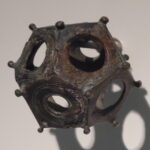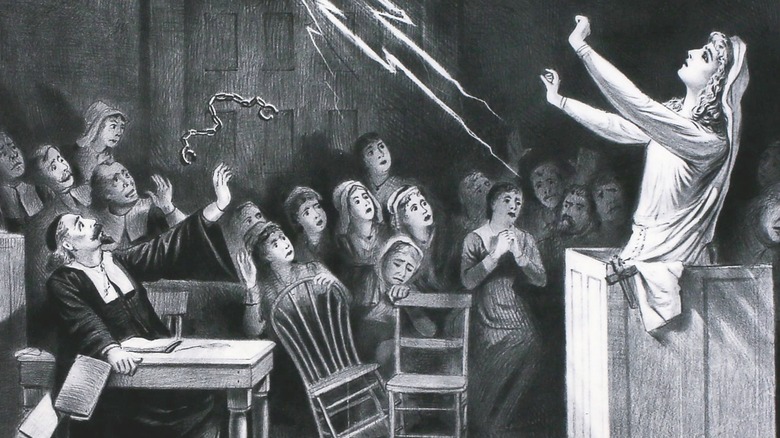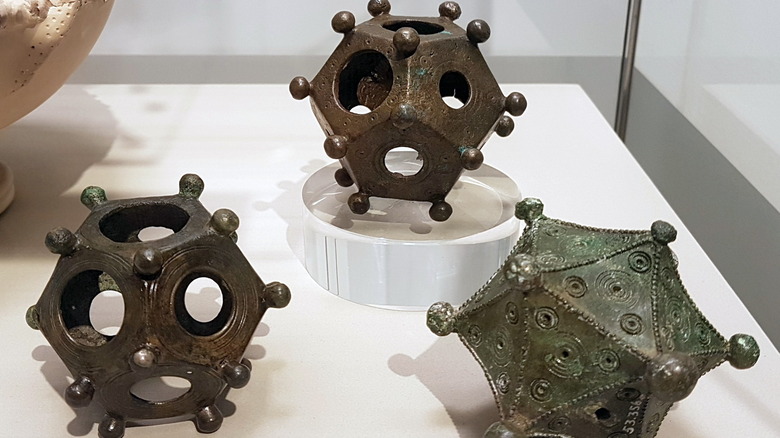
The Unsolved Mystery Of The Ancient Roman Dodecahedron
So we’re aware that, for all of our faults and foibles, human beings can also be pretty neat and clever, right? This is why people, not aliens, built the Pyramids at Giza (sorry, History Channel). This is why folks mastered fire and, during the Cognitive Revolution some 70,000 years ago (per Smithsonian Magazine), speech. And why, for instance, you can heft a rectangular prism of plastic and circuited silicates and go tap, tap, “Hey Google, what’s the weather going to be like tomorrow?”
For all the nifty technological elements of the modern age, it’s important to remember that every advance builds on a predecessor, and even basic everyday tools like eyeglasses and Scotch tape constitute revolutions in perception and behavior. Big monuments like Stonehenge might get a lot of attention, and rightfully so, but it’s little, quotidian artifacts that bear the weight of civilization. And among all such speculation, one truth remains: folks consistently underestimate the intelligence, wherewithal, and perspicacity of our forbears.
Some small historical artifacts of the past, though, like their monolithic, Stonehengian cousins, remain legitimate mysteries. Take a strange, twelve-sided, hand-held object found at dig sites of the Ancient Roman Empire, something that looks like a polyhedral precursor to 12-sided Dungeons and Dragons die. These strange, hollow and holed dodecahedrons performed a function in the ancient world that remains unknown to this very day.
A finely crafted hand-held polyhedron of the ancient world
The odd case of the Roman dodecahedron first came to light nearly 300 years ago, in 1739, over 1,300 years after the fall of the Western Roman Empire in 395 CE. No matter how much we know about Roman emperors, Roman myth, Roman historians, the lives of gladiators, senators, and the roles of women in society, this small object — small enough to be placed on a windowsill by accidental archaeologist Brian Campbell in 1987 after being found in his yard — remains a bizarre and baffling mystery.
As Mental Floss describes, the first “piece of mixed metal, or ancient brass, consisting of 12 equal sides” was discovered “buried in a field in the English countryside along with some ancient coins.” It was brought to the Society of Antiquaries in London, who described its finely crafted composition, pointing to “an equal number of perforations within [the sides], all of unequal diameters, but opposite to one another … every facing had a knob or little ball fixed to it.” Meaning: each hole on each face was a different size, and at each vertex (20 total) along the exterior there was a little, knobby ball.
Since then, more than 100 such objects have been found at Ancient Roman sites ranging from the 1st to the 5th century (far longer than humans have been using electricity, let alone iPhones), in sizes ranging from a “golf ball to a bit larger than a baseball.”
Polyhedral dice, knitting tools, candlesticks, or something else?
So far, explanations for the Roman dodecahedrons are varied and ultimately lacking in some way or another. As the Gralien Report says, interpretations of the objects include dice for games, candlesticks, religious artifacts, crop planting schedulers, and knitting aids. The knitting aid explanation has gotten some traction, as videos (such as posted on YouTube) show, where a dude uses a ceramic, 3D-printed version of a Roman dodecahedron to craft a shabby pair of what could generously be described as “gloves.” Ancient Worlds Manchester depicts a similar attempt with the headline, “Dodecahedron Mystery Solved?” to which an honest reply would be, “Not really.” (We’re putting our money on gag gift salt dispenser.)
It actually makes sense that small, commonplace ancient objects might be difficult to explain. “The more things change, the more they stay the same,” sure, but the opposite can also be true. No matter how much of human life has remained the same over millennia — cook, joke, play games, make art, make children — some tools are bound to be phased out as surely as VHS cassettes to Zoomers (unless they’re retro-chic). And besides, those Roman historians we mentioned? They’re much more concerned with grand, epic, self-confirming mythologies about emperors and the glory of Rome than they are whatever commonplace goods (if indeed the dodecahedrons were commonplace) Marcellus the Peasant had hanging around his hovel. For the present, it looks like the Roman dodecahedron has to remain a fun little mystery.

How Woodrow Wilson Surprisingly Got Caught In A Love Triangle

The Surprising Origin Of The 'At' Symbol

The Wild Story Behind The Salem Tomato Trial

Here's What We Know About The Real-Life Ocean's 11 Heist

How The Challenger Space Shuttle Explosion Could've Been Avoided

Animas Forks: The Truth About This Colorado Ghost Town

What You Didn't Know About Walt Disney's Propaganda Films

The JFK Theory That Would Change Everything

Do Witch-Hunters Still Exist Today?

A Look At Vincent Van Gogh's Love Affair
























